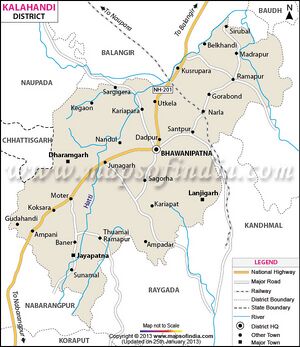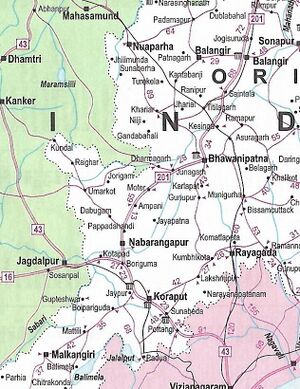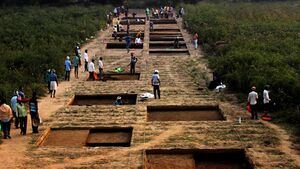Asurgarh
| Author:Laxman Burdak, IFS (R) |

Asurgarh (Hindi:असुरगढ़, Odia: ଅସୁରଗଡ) is an archaeological site in the Kalahandi district of Odisha, India. Carbon dating finds Asurgarh is the Odisha’s oldest fortified settlement. [1]
Variants
Location
Asurgarh is a small Village in Narala Tehsil in Kalahandi District of Odisha State, India. It is located 33 km towards North from District head quarters Bhawanipatna, 1 km from Narala, 305 km from State capital Bhubaneswar. Asurgarh Pin code is 766101 and postal head office is Rupra Road . Bhimkela ( 2 KM ) , Mandel ( 3 KM ) , Karmegaon ( 4 KM ) , Bagpur ( 6 KM ) , Narla ( 6 KM ) are the nearby Villages to Asurgarh. Asurgarh is surrounded by Kesinga Tehsil towards west , Titlagarh Tehsil towards west , Bhawanipatna Tehsil towards west , Madanpur Rampur Tehsil towards East . Bhawanipatna , Titlagarh , Kantabanji , Balangir are the near by Cities to Asurgarh.[2]
History
Asurgarh is one of the sites which has its beginning in around 8th-9th century BC and emerged as one of the early urban fortified settlements in the region and it is older than Sisupalgarh.
Archaeological evidence of Stone Age and Iron Age human settlement has been recovered from the region.[3] Asurgarh offered an advanced, well civilised, cultured and urban human settlement about 2000 years ago in the region.[4]
Carbon dating finds Asurgarh is Odisha’s oldest fortified settlement - The Asurgarh fortified settlement, which was excavated by the Archaeological Survey of India (ASI) in Odisha’s Kalahandi district, has been ascertained to be the oldest among the major fortified settlements in the State. It dates back to the ninth century BC.[5]
In South Asia it is believed that the lands of Kalahandi district and Koraput district were the ancient places where people started cultivation of paddy. In ancient time it was known as Mahakantara (meaning great forest) and Karunda Mandal, which means treasure of precious stones like karandam (corundum/manik), garnet (red stone), beruz, neelam (sapphire/blue stone), and alexandrite, etc. Manikeswari (the goddess of Manikya or Karandam) is the clan deity of Kalahandi may also signify its historical name.
Despite its backwardness it is one of the rich regions in history, agriculture, forest resources, gemstone, bauxite, folk dance, folk music, folklore, handicrafts and arts.
The archaeological record of the Tel Valley reveals the presence of the primates in its zones during the Pleistocenephase. Paleolithic is being documented in Kalahandi, like Moter river basin in Dharamgarh region.[6] One of the largest size axe of late Stone Age culture has been recovered from Kalahandi.[7] Tel river civilisation put light towards a great civilisation existing in Kalahandi in the past that is recently getting explored.[8] The discovered archaeological wealth of Tel Valley suggest a well civilised, urbanised, cultured people inhabited on this land mass around 2000 years ago[9] and Asurgarh was its capital. Kalahandi along with Koraput and Bastar was part of Kantara referred in Ramayana and Mahabharata.[10]
In the 4th century BC Kalahandi region was known as Indravana from where precious gemstones and diamonds were collected for the imperial Maurya treasury.[11] During the period of Maurya emperor Ashoka, Kalahandi along with Koraput and Bastar region was called Atavi Land.[12] This land was unconquered as per Ashokan record.[13]
In the beginning of the Christian era probably it was known as Mahavana.[14] In the 4th century AD Vyaghraraja was ruling over Mahakantara comprising Kalahandi, undivided Koraput and Bastar region.[15] Asurgarh was capital of Mahakantara.[16] After Vyaghraraja, the Nala kings like Bhavadatta Varman, Arthapati and Skanda Varman ruled over south part of this region up to about 500, the territory was known as Nalavadi-visaya[17] and rest of Mahakantara, lower part of Tel river valley was ruled by king Tastikara and his scions, the kingdom was known as Parvatad-waraka, whose headquarters was Talabhamraka near Belkhandi.[18]
Mahakantara (महाकांतार) was dense forested area in Chhattisgarh and Orissa comprising Kalahandi, undivided Koraput and Bastar regions. Asurgarh was capital of Mahakantara.
The first brick temple in Eastern India, the temple of Goddess Stambeswari, was built at Asurgarh during the 5th century AD.
Asurgarh is Odisha’s oldest fortified settlement
Carbon dating finds Asurgarh is Odisha’s oldest fortified settlement - The Asurgarh fortified settlement, which was excavated by the Archaeological Survey of India (ASI) in Odisha’s Kalahandi district, has been ascertained to be the oldest among the major fortified settlements in the State. It dates back to the ninth century BC.[19]
Key Findings from the Excavation:
- The settlement dates back to the ninth century BC.
- The landscape of Asurgarh attracted iron using people to begin their settlement around eighth-ninth century BC.
- The excavation revealed three periods of human occupation without any hiatus.
- The Iron Age: ninth century BC to fourth century BC.
- Early Historic or Rampart phase: second century BC to first century AD.
- The Late Period/Decline of the settlement: second century AD to third-fourth century AD.
- It is the only site in Odisha which shows highly skilled engineering of water management in comparison to contemporary sites.
Speculation
- Local inhabitants might have started to carve out a rural settlement in the landscape around 9th century BC.
- The settlement might have expanded between fourth century BC to second century AD.
- This era was contemporary to the Mauryan period.
- The settlement was built in such a way that water might have came from a distance of more than 5 km to enter the reservoir located in the eastern side of the fort.
- Layout of the outer fortification wall shows the efficiency of the water management system during the early historic period.
- There could have been a social hierarchy in the settlement.
- Asurgarh must have been inhabited by different groups such as potter, goldsmith, agriculturist and traders.
Antiques
- A total of 417 antiquities have been retrieved from the site.
- Beads of coral, carnelian, glass, garnet, shell, milky quartz, terracotta, and circular discs made out of potsherds and stone are among some of the antiquities.
- There were other objects such as a silver punch-marked coin of imperial variety, and bricks & terracotta roof tiles found at the site.
How the Settlement Declined?
- During 2nd century AD to 3-4 century AD, the fortified settlement is believed to have lost steam.
- It might have declined due to the territorial expansion of a neighbouring state like the Satavahana and early Gupta dynasties.
- It also declined to ecological changes.
Asurgarh Fort
It is almost rectangular in shape, having four gates piercing the surrounding mammoth wall made of brick, rubble and earth. After the wall, a wide and deep moat girdles the fort on three sides respectively, the north, south and east. The fort area measures 24.29 hectares of land. On the west of the fort, the river Sandol flows close to the western rampart towards north to meet the river Utei, a tributary of the Tel, at a distance of about 3 km from the fort site.
Close to the eastern ditch, the builders of the fort excavated a huge water reservoir measuring 200 acres of land. It is popularly known as Asursagar. It has been pointed out that the water of the reservoir could be trained into the ditch of the fort through two sluices gate. On the southwest corner of the fort, another small tank was dug, which is known today as Radhasagar. The Habitation zone of the inhabitants is documented towards the south and north of the fort immediately after the fortified wall. Lowe town or habitation area is further superimposed by another mud wall within 100 hectares radius at each settlement zone, the mud wall has a single gate in the middle.[20]
Archaeologists have unearthed artefacts believed to be 2,300-year-old while carrying out excavation at the Asurgarh Fort in Odisha’s Kalahandi district.[21] DB Garnayak, Archaeological Survey of India, says Asurgarh is one of the sites which has its beginning in around 8th-9th century BC and emerged as one of the early urban fortified settlements in the region by the efforts of tribal and non-tribal inhabitants of the region.[22] Lokesh Durga, Department of History of Delhi University, says Asurgarh settlement is older than Sisupalgarh and the first Urbanization process in Odisha started from Asurgarh. [23]
References
- ↑ Article by SATYASUNDAR BARIK, The Hindu, April 24, 2022
- ↑ http://www.onefivenine.com/india/villages/Kalahandi/Narala/Asurgarh
- ↑ B.Mishra, J. Bengal Art, Vol.9&10, 2004–2005, 383–410
- ↑ P.Mohanty, B. Mishra, Op. Cit,2000; C.R. Mishra, S. Pradhan, op. cit. 1989–1990, Infra, F.N.79
- ↑ Article by SATYASUNDAR BARIK, The Hindu, April 24, 2022
- ↑ R.P. Prusty, 1992, Paleolithic Vestiges from Kalahandi, Odisha Historical Research Journal, XXXVII, no.1-5, pp.55–66, Orissa State Museum, Bhubaneswar
- ↑ P. Mohanty, B. Mishra, Op. Cit,2001, p.47
- ↑ "A tale of Tel valley civilization uncovered". The New Indian Express.
- ↑ P.Mohanty, B. Mishra, Op. Cit,2000; C.R. Mishra, S. Pradhan, op. cit. 1989–1990, Infra, F.N.79
- ↑ Mahabharata (II.28.10)/2-32-14a)
- ↑ Proceedings, Indian History Congress, 1947, 10th session, 178
- ↑ Rayachoudhury, H. C. (1923). Political History of Ancient India. Calcutta University. p. 538.
- ↑ B. Mishra, op.cit., 2003–2004
- ↑ N. K. Sahu, 1964, op. cit.
- ↑ N. K. Sahu, op.cit., 1964, p.200
- ↑ ibid.7
- ↑ N. K. Sahu, Utkal University, History of Orissa, 433
- ↑ S.P.Tiwari, Comprehensive History of Orissa, 95–96
- ↑ Article by SATYASUNDAR BARIK, The Hindu, April 24, 2022
- ↑ 1. S.C.Behera(ed.), 1980, Interim Excavation Report, Asurgarh, pp 1-7, Sambalpur University; 2. DB Garnayak, 2020. Excavation at Asurgarh: An Early Historic Fortified Settlement in Odisha , Vol. 8.2, Heritage: Journal of Multidisciplinary Studies in Archaeology; 3. LK Durga, 2018. Process of Peripheralization of Settlements in Early Historic Odisha: An Archaeological Perspective, Vol. 6, Heritage: Journal of Multidisciplinary Studies in Archaeology
- ↑ Barik, Satyasundar (20 January 2019). "ASI finds 2,300-year-old artefacts in Odisha" – via www.thehindu.com.
- ↑ Express News Service, 11th April 2022. Asurgarh fort settlement belongs to Iron Age, older than Sisupalgarh. https://www.newindianexpress.com
- ↑ 1. Express News Service,11th April 2022. Asurgarh fort settlement belongs to Iron Age, older than Sisupalgarh. https://www.newindianexpress.com; 2. Barik, Satyasundar, (APRIL 24, 2022). Carbon dating finds Asurgarh is Odisha’s oldest fortified settlement, https://www.thehindu.com
Back to Orissa Back to Jat Kingdoms in Ancient India/Jats in Buddhism

